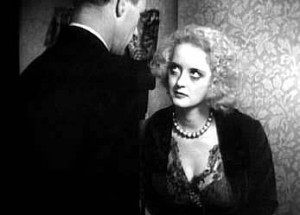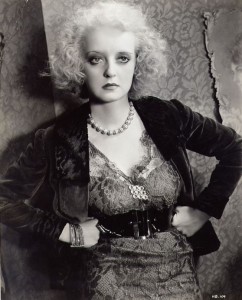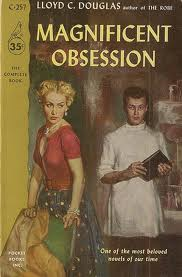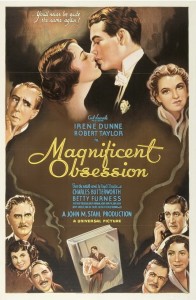Posted by Sarah
Ann-Marie has very kindly provided an extended introduction to Of Human Bondage (1934) which will be screened on Wednesday 9th of October at 4pm-7pm in Keynes Seminar Room 6. The introduction includes reflection on a ‘Bette Davis’ performance; why Davis suits melodrama; Of Human Bondage and Davis; and some matters to consider whilst watching the film.
What makes a Bette Davis performance?
- Eyes – Notice the shifts, the way they flair in moments of high emotion, and the hood of the eyelids in moments of reflection.
- Nervousness and sudden gestures
- Clipped voice
- Striding walk
- Quick shifts in mood
- Empathetic
- Constant movement – Places attention on the body and makes gestures such as the clenching of the fists vivid.
- High emotion
- Often anti-glamour
- Calls attention to its own skill

Davis always knew what came before and after each scene to help give a performance continuity. Her dedication to her craft developed a star status that relied on the knowledge of Davis the actress, and not the glamour aspects of stardom. Davis was so revered during her time that she was asked to contribute to the 1937 book We Make the Movies, in which she wrote an article on acting.
Why does Davis suit Melodrama?
‘Natural! That isn’t the point of acting.’ (Davis 1962, p. 141)
Both in The Lonely Life and subsequent interviews with Davis she has claimed that acting should be removed from life. Davis disliked the method, preferring escapism and theatrics as a way to entertain an audience. The theatrical style of Davis lends itself to high emotion and exaggeration that complements the melodramatic form. There is a ‘certain hysteria or hysterical energy’ (Cavell 1996, p. 127) that exudes from Davis on film and enhances a situation. When Mildred rushes through Philip’s apartment she is like a storm. Mildred destroys everything in her path with an intensity that could only be performed by Davis.
Bette is best when she is being bad, and ‘lying proved to be one of the most dominant themes of the Bette Davis film’ (Shingler and Gledhill 2008, p.74). However, lying is not restricted to her cruel roles, it is also the case when she is the sympathetic heroine, see Dark Victory. Academics have noted that her over-acting is acceptable because ‘her characters were supposed to be performing, hence behaving unnaturally’ (Shingler and Gledhill 2008, p.74). Davis plays the woman with a secret or a hidden agenda, and is often a type of enigma to the other characters in her fictional world. It is the combination of Davis not being as she seems and her elaborate gestures that enhance the melodrama on screen.
Of Human Bondage and Davis.
Bette Davis was warned against this role, but she felt she needed a part that would push and showcase her acting abilities. The gamble paid off and Davis was rewarded with critical praise. Many Davis enthusiasts, particularly biographers, class this role as an unofficial Academy Award nomination. Voters were appalled that Davis was left out of the nominations and a write-in ensued. However, it would not take Davis long to gain two Academy Awards in that same decade.
Like many Davis characters ‘“acting” [is] the core of the character’ (Shingler and Gledhill 2008, p.72). Mildred’s performance extends to multiple levels, for instance: The manipulation of Philip and her voice. The manipulation of Philip is for her benefit, particularly in a place to stay and for money. However, her voice is a performance for everyone in the fictional world. Her strange cockney accent was an attempt by Davis to show Mildred’s real background and her fight to make herself sound refined. Shingler also comments on this, stating that Davis attempts to ‘reflect the natural cadences of the dialect […whilst] betray[ing] her as “fake”’ (Shingler 1999, p.52). In melodrama people are often not how they seem, and this is often exemplified by the multi-faceted Davis, especially as Mildred.
Perhaps the most noted part of her performance can be found in the tirade on Philip. It is a ‘display of hysteria, fury, and bitterness, edged with vulnerability’ (Shingler 1999, p.47). Note the build of emotion, not just in her voice but through the repetition of actions
and the slow increase of her performance tics. It is this scene combined with the importance of her eyes that Shingler notes in his article ‘Bette Davis: Malevolence in Motion’. However, it seems that Davis’ slow build-up of the true nature of Mildred is vital to her performance. Through Davis we learn the character’s true self because her over-acting makes it clear that Mildred is a fake, and thus, Mildred’s tirade is electric because it is the release of the ‘real’ Mildred, a moment that justifiably needs to be heightened over the ‘controlled’ persona.
Things to consider whilst watching the film.
- How the failure of manipulation breaks Mildred’s “acting” and how this serves the melodramatic performance.
- How the Davis performance tics enhance melodrama.
- The Davis eyes as tool to truth – consider the presentation before and during the death scene.
- Costume and the unglamorous Bette.
Questions from the last post that could also be considered
- What are the components of a melodramatic performance?
- How much of an influence does performance have on establishing a genre?
- Or, perhaps, do stars carry a performance type that will affect the categorizing of a film?
- Davis admitted that her performance style was theatrical rather than realistic. Is it this style that we find in most melodramas?
- How does performance differ between radio and film? How does this affect melodrama?
Note: This film has less than perfect sound. Sadly, the film in that aspect has not aged well.
References
Cavell, S. (1996). Contesting Tears, The Hollywood Melodrama of the Unknown Woman. Chicago: The University of Chicago Press.
Davis, B. (1962) The Lonely Life. New York: G.P Putnam & Sons.
McNally, P (2008). Bette Davis, The Performances That Made Her Great. Jefferson: McFarland and Company, Inc., Publishers.
Shingler, M. and Gledhill, C. (2008). ‘Bette Davis: Actor/Star’. Screen. 49 (1), p67-76.
Shingler, M. (1999). ‘Bette Davis: Malevolence in Motion’. In: Lovell, A. and Kramer, P. eds. Screen Acting. London: Routledge.









